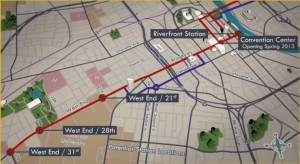BRT for Music City: getting connected
[Originally posted by InsideVandy]
Megan Barry summed things up nicely: “We can’t lay down any more asphalt, so it’s time to actually solve the problem.”
Barry, a former adjunct faculty member at Vanderbilt who currently serves as the Nashville

Metro Council member at-large, was referring to the impetus for the East-West Connector, Nashville’s ambitious public transit project designed to shake up West End in the coming years. A bus rapid transit system, or BRT, the Connector will run 7.5 miles across one of Nashville’s main corridors, from White Bridge Road to Five Points.
The project was put into action in December 2011 by Mayor Karl Dean, green-lighting a system of dedicated BRT lanes running through the corridor with projected downtown stops at Broadway and at 2nd Avenue — an endeavor set for completion by mid-2015. A video on Metropolitan Transit Authority’s website highlights three potential stations on the edge of the Vanderbilt campus, at the intersections of West End with 31st, 28th and 21st Avenues.
“Any time you build a city around a river, you’re going to end up with an east side and a west side, which Nashville has always had,” Barry said. “Over time, those two need to be more intercritically linked. On both sides, you have populations who want to enjoy the hospitality of both, so the BRT, the East-West Connector, is one way to do that. It also helps bring all those people on the east and west side down to downtown so that they can enjoy downtown but also so they can get to work quicker.”
Gail Carr Williams, associate director of Vanderbilt’s Office of Community, Government and Neighborhood Relations and a member of the nonprofit Transit Alliance of Middle Tennessee, said the connector would help Vanderbilt students get around Nashville easier just as much as it would help the Nashville community connect with the campus more efficiently.
“We’ve seen increased ridership on that whole corridor over the recent years that really gave rise to thinking we could have something a little faster, a little better like a lot of other cities, that would really connect us more,” Williams said.
The East-West corridor is intended to be only the first line of a project down a major artery of Nashville’s infrastructure, to be enhanced later by the construction of a spoke system of BRT lines.
“The way that you build transportation infrastructure is to make sure that you have density, and so what you’re going to see change over the next several years is going to be along those corridors, you’re going to have to have more density,” Barry said. “Anywhere we have a pike, all those pikes are going to see tremendous growth.”
According to MTA Nashville, approximately 25,200 people in 13,450 households live along the corridor today, accounting for a population density twice that of the metro area as a whole.
“If you’re thinking about that BRT running along West End, you would think about a stop that would get people to Caterpillar (Financial Services), you would think about getting people to Vanderbilt and the Vanderbilt Medical Center,” Williams said. “And then on the other side of West End, where you think ‘How do I get a large population to Baptist and over to Centennial? How are we crossing both sides of West End, the Vandy side and beyond?’ We’re talking about the totality of a community.”

Leave a Response